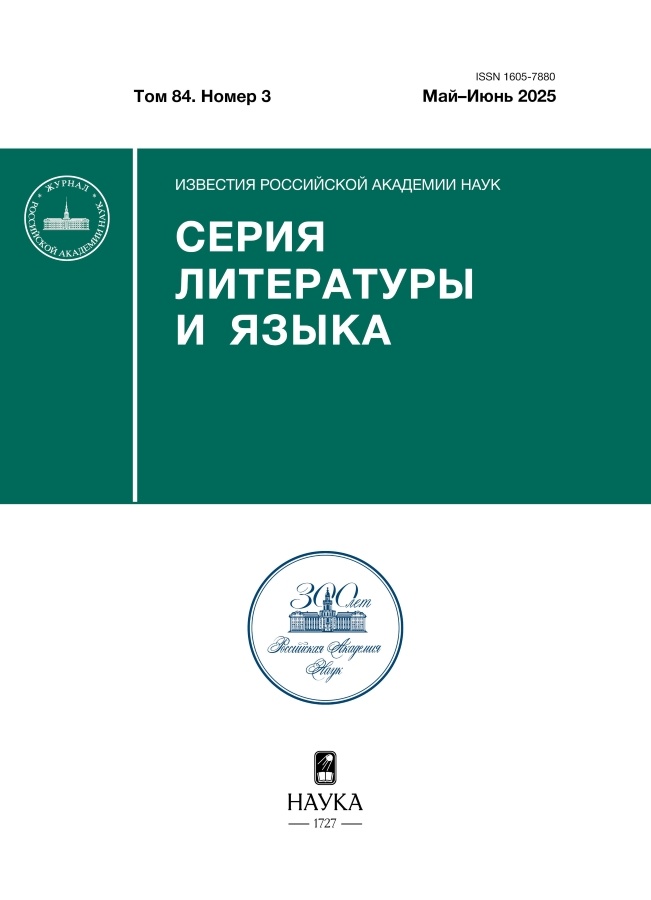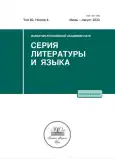Фазовая полярность: нарушенное ожидание или контраст?
- Авторы: Волков О.С.1
-
Учреждения:
- Институт языкознания РАН
- Выпуск: Том 82, № 4 (2023)
- Страницы: 82-90
- Раздел: Статьи
- URL: https://gynecology.orscience.ru/1605-7880/article/view/656953
- DOI: https://doi.org/10.31857/S160578800027393-8
- ID: 656953
Цитировать
Полный текст
Аннотация
В статье делаются некоторые наблюдения о семантике частиц типа русского уже. Мы предполагаем, что определяющую роль в семантике таких частиц играет контрастивность – и она же является ключом к тому, что в некоторых языках подобные показатели начинают функционировать как перфектные. Статья состоит из двух частей. Первая часть посвящена семантике русской частицы уже; во второй части статьи кратко рассматриваются показатели ямитива – мы предполагаем, что их функционирование в целом можно описать с помощью того же анализа, который предложен в первой части для русского уже.
Ключевые слова
Об авторах
О. С. Волков
Институт языкознания РАНРоссия, 125009, Москва, Большой Кисловский пер., д. 1, стр. 1
Список литературы
- Van Baar, T.M. Phasal Polarity. Amsterdam: IFOTT. 1997.
- Van der Auwera, J. Phasal adverbials in the languages of Europe. J. van der Auwera, D. Ó Baoill (eds). Adverbial constructions in the languages of Europe. Berlin: Mouton de Gruyter, 1998, pp. 25–145.
- Plungian V.A. A typology of phasal meanings. Abraham W., Kulikov L. Tense-aspect, transitivi-ty, and causativity: Essays in honor of Vladimir Nedjalkov. Amsterdam: John Benjamins, 1999, pp. 311–321.
- Givón T. Forward Implications, Backward Presuppositions, and the Time Axis of Verbs. John P. Kimball (ed.). Syntax and Semantics. New York and London: Seminar Press, 1972, pp. 29–50.
- Падучева Е.В. Высказывание и его соотнесённость с действительностью. М.: Наука, 1985.
- Мустайоки А. О Семантике Русского Темпорального ещё. Studia Slavic Finlandesia (Доклады финской делегации на X Съезде cлавистов), 5. 1988. C. 99–142.
- Богуславский И.М. Сфера действия лексических единиц. М., 1996.
- Богуславский И.М.“Сандхи” в синтаксисе: загадка уже не // Вопросы языкознания. 2002. № 5. С. 19–37.
- Перцов Н.В. О возможном семантическом инварианте русских фразовых частиц уже и ещё // Логический анализ языка. Семантика начала и конца. М., 2002. С. 137–144.
- Труб В.М. Темпоральные частицы как знаки начала и конца ситуации // Логический анализ языка. Семантика начала и конца. М., 2002. С. 334–447.
- Труб В.М. Особенности интерпретации высказываний с заполненными темпоральными валентностями частиц ещё и уже // Сокровенные смыслы. Слово. Текст. Культура. Сбор-ник статей в честь Н.Д. Арутюновой / Под ред. Ю.Д. Апресяна. М., 2004. С. 333–343.
- Israeli A. The expression of temporal still in Russian.Studies in Polish Linguistics, 3, 2006, pp. 113–125.
- Урысон Е.В. Уже и уж: вариативность, полисемия, омонимия? // Труды международной конференции “Диалог 2007”, 2007. URL: http://www.dialog-21.ru/digests/dialog2007/materials/html/81.htm
- Левонтина И.Б. Загадки частицы уж // Труды международной конференции “Диалог 2008”, 2008. URL: http://www.dialog-21.ru/digests/dialog2008/materials/html/47.htm
- Рахилина Е.В. К аспектуальным свойствам русского уже // М. Китадзё (сост.). Аспекту-альная семантическая зона: Типология систем и сценарии диахронического развития. Сб. статей V Международной конференции Комиссии по аспектологии Международного ко-митета славистов. Киото: Университет Киото Сангё, 2015. С. 214–220.
- Krifka M. Alternatives for aspectual particles: Semantics of still and already. Paper presented at the Berkeley Linguistics Society, 2000.
- Plungian V.A., van der Auwera J. Towards a typology of discontinuous past marking // Sprachtypologie und Universalienforschung 2006, 59, № 4, рр. 317–349.
- Стойнова Н.М. Буду делать vs. стану делать: корпусные данные. Конференция “Русский язык: конструкционные и лексико-семантические подходыˮ. СПб., ИЛИ РАН, 12–14 сен-тября 2013.
- Olsson B. Iamitives: Perfects in Southeast Asia and beyond. MA Thesis, University of Stock-holm, 2013.
- Besnier N. Tuvaluan. London and New York: Routledge, 2000.
- Hooper R. Tokelauan. Lincom Europa, 1996.
- Bauer W. Maori. London and New York: Routledge, 1993.
- Mosel U., Hovdhaugen E. Samoan Reference Grammar. Oslo: Scandinavian University Press, 1992.
- Vonen A.M. The expression of temporal and aspectual relations in Tokelau narratives. Bache, Basbøll, Lindberg (eds). Tense, Aspect and Action. Berlin, New York: Mouton de Gruyter, 1994, pp 371–397.
- Hooper R. Universals of narrative pragmatics: А Polynesian case study. Linguistics, 1998. 36. 119–160.
- Matthewson L., Quinn H., Talagi L. Inchoativity meets the perfect time span: The Niuean perfect. Lingua. 2015, No. 168 (1), pp. 1–36.
- Плунгян В.А. Введение в грамматическую семантику. Грамматические значения и грамматические системы языков мира. М.: РГГУ, 2011.
- Михайлов С.К. Фантастические аспектуальные твари и откуда они возникают: инкомпле-тив // ВАПросы языкознания: Мегасборник наностатей. Сб. ст. к юбилею В.А. Плунгяна. 2020. С. 415–420.
Дополнительные файлы








